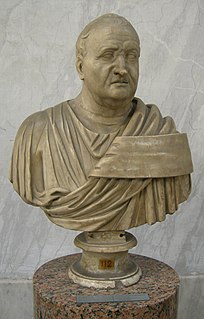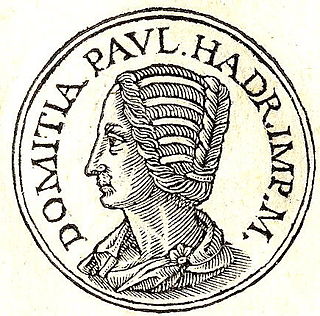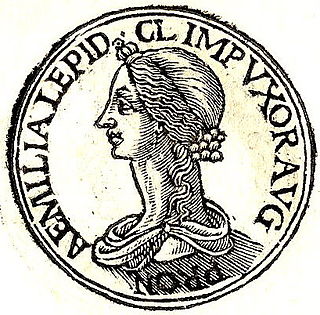Related Research Articles

Julia Agrippina, also referred to as Agrippina the Younger, was a Roman empress and one of the most prominent women in the Julio-Claudian dynasty. Her father was general Germanicus, one-time heir apparent to the Roman Empire under Tiberius; and her mother was Agrippina the Elder, a granddaughter of the first Roman emperor Augustus. She was the younger sister of emperor Caligula, the niece and fourth wife of emperor Claudius who succeeded Caligula, and the mother of emperor Nero, who succeeded Claudius.

Domitian was Roman emperor from 81 to 96. He was the son of Vespasian and the younger brother of Titus, his two predecessors on the throne, and the last member of the Flavian dynasty. During his reign, the authoritarian nature of his rule put him at sharp odds with the Senate, whose powers he drastically curtailed.
Gnaeus Julius Agricola was a Roman Italo-Gallic general responsible for much of the Roman conquest of Britain. Written by his son-in-law Tacitus, the De vita et moribus Iulii Agricolae is the primary source for most of what is known about him, along with detailed archaeological evidence from northern Britain.

The Julio-Claudian dynasty comprised the first five Roman emperors: Augustus, Tiberius, Caligula, Claudius, and Nero. They ruled the Roman Empire from its formation under Augustus in 27 BC until AD 68, when the last of the line, Nero, committed suicide. The name "Julio-Claudian" is a historiographical term derived from the two families which composed the imperial dynasty: the Julii Caesares and Claudii Nerones.

Around the start of the Common Era, the family trees of the gens Julia and the gens Claudia became intertwined into the Julio-Claudian family tree as a result of marriages and adoptions.

Livia Drusilla, also known as Julia Augusta after her formal adoption into the Julian family in AD 14, was the wife of the Roman emperor Augustus Caesar throughout his reign, as well as his adviser. She was the mother of the emperor Tiberius, great-grandmother of the emperor Caligula, grandmother of the emperor Claudius and the great-great-grandmother of the emperor Nero. She was deified by Claudius who acknowledged her title of Augusta.

Domitia Longina was a Roman empress and wife to the Roman emperor Domitian. She was the youngest daughter of the general and consul Gnaeus Domitius Corbulo. Domitia divorced her first husband, Lucius Aelius Lamia Plautius Aelianus in order to marry Domitian in AD 71. The marriage produced only one son, whose early death is believed to have been the cause of a temporary rift between Domitia and her husband in AD 83. She became the empress upon Domitian's accession in AD 81, and remained so until his assassination in AD 96. She is believed to have died sometime between AD 126 and AD 130.

Gnaeus Domitius Ahenobarbus was a member of the imperial Julio-Claudian dynasty of Ancient Rome. Domitius was the son of Antonia Major. He married Agrippina the Younger and became the father of the Emperor Nero.

Domitia, more commonly referred to as Domitia the Elder -- in fact no ancient source ever calls her Lepida - was the oldest child of Antonia Major and Lucius Domitius Ahenobarbus, and the oldest granddaughter to triumvir Mark Antony by Octavia Minor, a great-niece of the Roman Emperor Augustus, second cousin and sister-in-law to the Emperor Caligula, first cousin to the Emperor Claudius, maternal aunt to the Empress Valeria Messalina, and paternal aunt to Emperor Nero.
Aemilia Lepida is the name of several ancient Roman women belonging to the gens Aemilia. The name was given to daughters of men belonging to the Lepidus branch of the Aemilius family. The first Aemilia Lepida to be mentioned by Roman historians was the former fiancée of the younger Cato. Subsequent Aemiliae are known because of their marriages.
Gaius Sallustius Passienus Crispus was a prominent figure in the Roman Empire during the first century. He held the consulship twice, and was stepfather of the future emperor Nero.
Appius Junius Silanus, whom Cassius Dio calls Gaius Appius Silanus, was consul in AD 28, with Publius Silius Nerva as his colleague. He was accused of majestas, or treason, in AD 32 along with a number of senators, but he and Gaius Calvisius Sabinus were saved by one of the informers, Celsus, a tribune of a city cohort.

Paulina or Paullina was a name shared by three relatives of the Roman Emperor Hadrian: his mother, his elder sister and his niece.
Domitia was a Roman noble woman who lived in the 1st century. She was the eldest daughter to Roman Consul and General Gnaeus Domitius Corbulo and Cassia Longina, who was daughter of Junia Lepida. Her younger sister was Domitia Longina, a future Roman Empress who would marry the future Roman Emperor Domitian. Her paternal aunt was Roman Empress Milonia Caesonia.

Aemilia Lepida was a noble Roman woman and matron. She was the first great-grandchild of the Emperor Augustus.
Gaius Cassius Longinus was an Ancient Roman jurist and politician from the first century AD. A grandnephew of Servius Sulpicius Rufus, he was also a nephew or great-grandson of Gaius Cassius Longinus, one of Caesar's assassins. Longinus was suffect consul of the second half of the year 30 as the colleague of Lucius Naevius Surdinus.

Ulpia was a noble Spanish Roman woman from the gens Ulpia during the 1st century CE.
The gens Domitia was a plebeian family at ancient Rome. The first of the gens to achieve prominence was Gnaeus Domitius Calvinus, consul in 332 BC. His son, Gnaeus Domitius Calvinus Maximus, was consul in 283, and the first plebeian censor. The family produced several distinguished generals, and towards the end of the Republic, the Domitii were looked upon as one of the most illustrious gentes.
Lucius Annius Vinicianus was a Roman senator during the later part of the first century. He is best known from a failed plot to overthrow Nero in 66 CE.